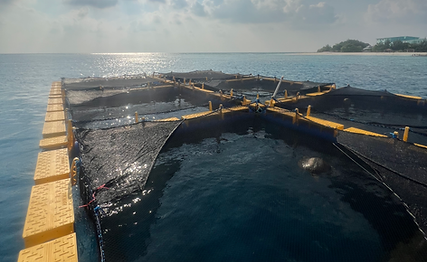
Goal
Sea Turtle Rescue
& Rehabilitation
Sea turtle rehabilitation looks a bit different wherever you go, but here's how we do it at Atoll Marine Centre:
Daily duties
What activities do we complete daily to look after our patients?

Netting out is an essential part of our morning tasks. To keep the turtles' tanks clean, we must remove any feces or debris. Utilising long handled nets and brooms, we net out as well as possible to provide the cleanest environment we can for our patients.
Netting out
Food preparation is done daily. We make a specifically calculated diet of tuna, mussels, shrimp and squid which is based on our patients weight and calculated by our Vet. Sometimes the sea turtles get a special treat, such as live crabs or king prawns!


Feeding
Food preparation
Hand in hand with food prep, the turtles get fed each day. Adult turtles are fed once a day, but juveniles or new admissions are fed twice a day, in the morning and again in the afternoon. We use different forms of enrichment feeding based on each individual patient's injuries or condition. We love watching them forage for their seafood!
For our Green Sea Turtle patients, we make sure to collect fresh seagrass daily to meet their vegeterian needs. We take time to snorkel out on the seagrass beds just infront of our centre, and collect the seagrass in a sustainable way so it can grow back easily. Then, we place it into an enrichment feeding device, allowing the turtles to forage this leafy green treat as they would in the wild.
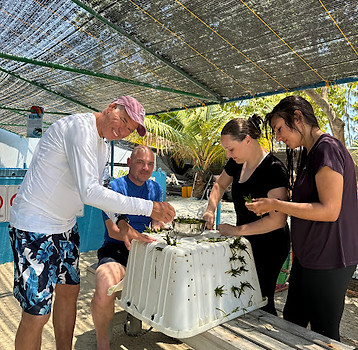
Seagrass collection
Weekly duties
What are the weekly tasks that are necessary to rehabilitation?
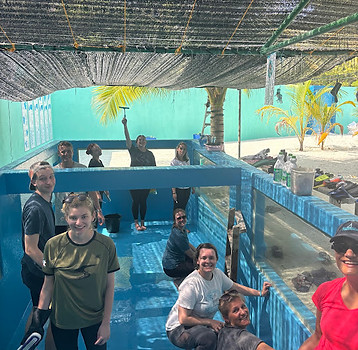
Tank deep cleaning
Tank cleaning is an essential part of keeping our turtles' environments clean. Every two weeks, we deep clean each tank - but dont worry! we schedule them in a continuous rota so we dont have to clean a tank every single day. We start by scrubbing the walls and floor with freshwater to remove any algae, and then disinfect each surface before rinsing and filling it back up with seawater.
Every-so-often duties
What are other tasks that are necessary, but not scheduled?
Weigh & measure
Weighing and measuring is an important part of every single turtle's rehabilitation monitoring. From this data, we can understand weight gain or loss, and growth. This also gives us a chance to give the turtles a bit of a spa day - to clean up some of their algae!
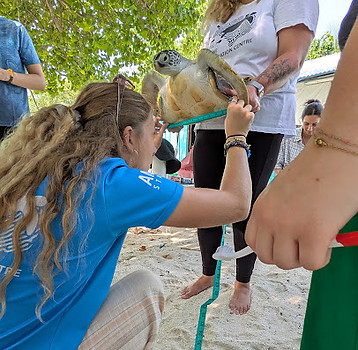
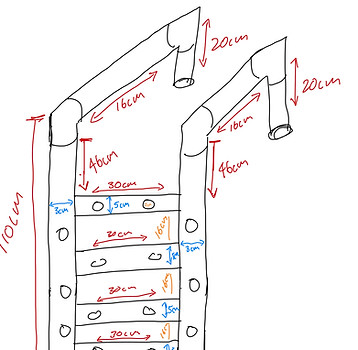
Enrichment design
Designing new enrichments, whether that is by staff, volunteers or interns, is always incredibly helpful to us at the centre. We are always tryng to improve our patients' quality of life and enrichment, so new ideas are always welcome!
Veterinary duties
What are the veterinary tasks that are necessary to rehabilitation?
Initial admission and check ups
Once a new sea turtle has arrived at our centre, we need to begin the admission process. This veterinary procedure includes initial examinations like heart rate, blood analysis and wound analysis. We record all of this data for our important logs, which allows us to understand and track a sea turtle's rehabilitation journey right from the start.

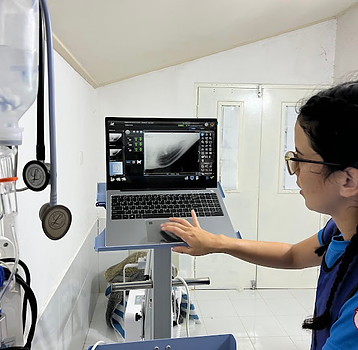
X-rays and further examination
X-rays are necessary to understand the health of our new admissions' lungs and organs. We can identify certain injuries like broken bones or extreme buoyancy syndrome from our X-rays, which helps the vet decide the next procedures and steps within that patient's rehabilitation.
Administration of medicine and wound care
Some of our sea turtle patients require medicine to make them heal better. Whether this is antibiotics, fluids or anti-fungals, our vet administers them in the least stressful way possible, always putting the turtle's welfare first and monitoring their stress levels. For our turtles that suffer with entanglement or boat strike wounds, our vet monitors them and provides the necessary care for the wounds to heal fully and as fast as possible.
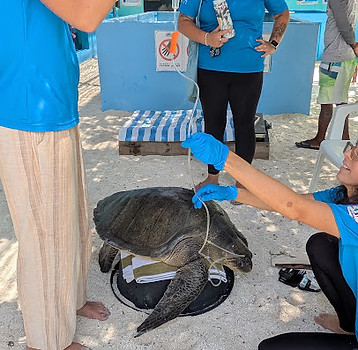
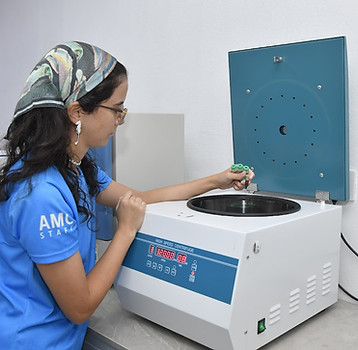
General upkeep and vet tasks
We are incredibly grateful that our vet works tirelessly to provide the best possible care for our patients at the centre. There is a lot of work behind the scenes that our vet completes, such as upkeep of veterinary medicine logs, cleaning and sanitisation, writing of medical reports and constant research of new and improved ways to carry out sea turtle rehabilitation. Without our dedicated and passioante vets, Atoll Marine Centre would be lost!
OCEAN REHABILITATION
Floating Marine Centre
Atoll Marine Centre's Floating Marine Centre was funded by a grant from the United Nations Development Program (UNDP) and implemented into the waters just in front of the centre in early 2023. This is the first of its kind in the Maldives, and allows us to provide a final step of rehabilitation for our sea turtle patients before they are released into the ocean.
Our sea cage is 5m deep and 9m wide, giving our turtles lots of space to get better. It exceeds EPA standards for turtle rehabilitation tank size. While it doesn't compare to the expanse of the ocean, it certainly gives them the space to get them diving again.
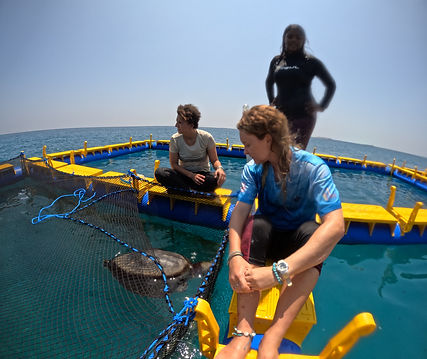

The Floating Marine Centre consists of 6 sea cages, made from durable nets and floating buoys, in which we can house turtle patients. The cages are also customisable, so we can create larger sections if necessary for the turtles. It is positioned in water between 15-20 meters in depth, as to not harm any of the reef which surrounds it. Our sea cage allows our turtles to be in a more natural and enriching environment during their rehabilitation. Being back in the ocean motivates the turtles to exhibit natural behaviours like practicing their diving. The ocean is where turtles are supposed to be, and the sea cage exponentially speeds up the rehabilitation process.
Life in the sea cage is a lot less disruptive to our turtles. The only interaction the turtle will experience is daily feeding and monitoring by our marine biologists.
It takes a lot more muscle to swim in the ocean compared to a tank. Letting our turtles complete their rehabilitation process in the sea cage builds their muscles back up for their release.
